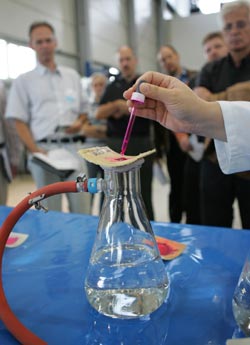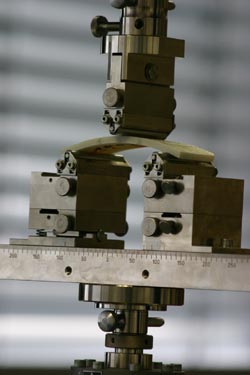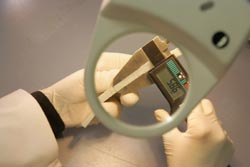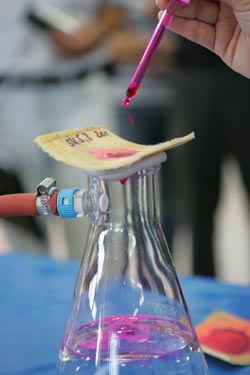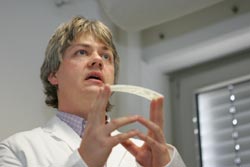IKT-LinerReport 2006: Glass Clearly Ahead? | ||
| ||
|
Is the material the only important factor in cured-in-place pipe rehabilitation? What quality standards do installers (contractors) achieve, and with what types of liner? The independent and neutral IKT Test Center for Pipe Liners now submits, for the third time, its IKT-LinerReport. This paints for 2006 a differentiated picture based on test results obtained from more than one thousand on-site samples. Industry experts are increasingly questioning which are the best liner types and the best pipe lining methods. Two „families“ of technologies compete in the marketplace: Tube liners employing glass-fiber, and those employing needle-felt, as the support material. It is no surprise that the various manufacturers emphasize only the benefits of their own systems. But what are the facts? What results are actually achieved on the building site? The IKT-LinerReport 2006 provides answers to these questions on the basis of laboratory results obtained by the independent and neutral IKT Test Center for Pipe Liners. | ||
|
Material and Man Pipe liners are, in principle, new pipes produced from ultra-modern composite materials. They are manufactured and cured at the construction site, however. Unlike pipes produced in a factory, these onsite cured pipeliners are subject to adverse conditions which frequently prevail on such sites. These conditions will differ significantly from location to location but the correct installation and cure must, nonetheless, be mastered at each location to achieve expected results and success. This necessitates the highest qualities in the raw support materials and resins used. Only a highly experienced and well coordinated team, fully in control of the complex installation and curing processes, can produce from the raw materials, a tight fitting, structural and leakproof liner which will stand up to several decades of pipeliner service. | ||
|
Data-base The data for all installation companies for whom the IKT has performed at least twenty-five liner tests from five different sites in the course of the year (January to December, 2006) has been incorporated into the 2006 LinerReport. In case of repeat tests, the most recently obtained result is used, provided the repeat tests were also performed at IKT. This report is based on a total of 1084 site samples taken at construction sites throughout Germany and thoroughly tested at the IKT laboratory. The 2006 IKT-LinerReport submitted herewith provides an overall view of tube liner qualities, classified by installation companies and liner systems. It follows the 2003/2004 and 2004/2005 LinerReports, and is therefore the Institute‘s third report of this type (see IKT-LinerReport 2003/2004 and IKT-LinerReport 2004/2005 on www.ikt.de). | ||
|
Significance and Limits of Information The laboratory results, obtained from site samples, cannot be used as the sole criteria for assessment of specific lining projects, since site specimens are only, at best, random samples. They are normally taken in the manhole or, in exceptional cases, directly from the pipe. The overall condition of a renewed pipe can be evaluated only if further acceptance inspection procedures, such as camera inspection or internal manual inspection, are also included. Only these other methods detect wrinkles, incorrectly re-opened service connections and physical defects in the pipeliner. The IKT-LinerReport can therefore not constitute the only standard for comparative assessment of installation companies and their liner systems. It provides results based on only one – but extremely important – aspect of quality assurance: laboratory testing. | ||
|
Specified/Actual Analysis At least four different parameters are generally used for the assessment of building site samples:
In the case of the first three (mechanical) parameters, the specified results are compared against those actually achieved (Specified/Actual analysis). The fourth criterion, water-tightness or porosity, is determined in accordance with the APS test and inspection code. The result is either „Porous“ or „Non-Porous“. | ||
|
Costumers Must Test The clients for tests in 2006 included both municipalities and installers. IKT has, however, always emphatically recommended that municipal clients (or their consultant engineers), rather than the installers, should select and commission the testing institute directly. The testing function must not be left to those who’s products are being tested. In this way, potential attempts at influence, by such companies, can be eliminated from the beginning. The majority of tests performed at IKT, a total of 82 %, were conducted on behalf of the municipal client (see Table 1).
| ||
|
Modulus of Elasticity Pipe liners are required to withstand locally differing loads (groundwater, traffic loads, soil pressure etc.). They therefore need to be designed specifically for these loads in each case, and to possess adequate load-bearing capability. A central mechanical characteristic parameter in this context is modulus of elasticity. The test method applied in the case of site samples is the threepoint bending test, which IKT performs in the form of a short-time test with reference to DIN EN ISO 178 and DIN EN 13566, Part 4 (see Table 2). | ||
|
Flexural Strength Flexural strength indicates the point at which the liner fails as a result of excessively high stress. If this point is too low, the liner does not possess adequate load-bearing capability and may fail before the permissible load is reached. Test method: The load in the three-point bending test is raised at a constant rate of deformation up to the first fall in loading. This indicates the inception of liner failure (short-time test, see Table 3).
| ||
|
Wall Thickness The third criteria relevant for assessment of the load-bearing capability of liners is wall thickness (Mean Combined Thickness em as per DIN EN 13566, Part 4). A specified figure (for the stressanalysis calculation, for example), is made for this and must be achieved during production of the liner on site. Test method: The statically loadbearing wall thickness is measured at six points using a precision slide gauge. Inner and outer films and non-structured layers consisting purely of resin (surplus resin layers) are not taken into account in this measurement (see Table 4). | ||
| ||
|
Water-Tightness as per APS Test method: Any outer film is firstly removed from the sample and a specified pattern is cut into the inner film. Water containing a red dyestuff is then applied to the inner side and an „underpressure“ (partial vacuum) of 0.5 bar is applied to the exterior side. The liner is „Porous“ (not water-tight) if droplets, foam or moisture form on the outer side (see Table 5). | ||
| ||
|
Liner Types and Liner Systems Analysis of the liner types and systems evaluated and tested indicates the following (see Table 6):
| ||
|
Installation Contractors The quality of execution by the installers is however, also a critical factor in the achievement of success. This is apparent, in particular, in the case of liner systems which are used by more than one company, i.e., Berolina Liners, Brandenburger Tube Liners, City-Liners and Saertex-Liners. The scatter bandwidth of rates of success (percentage of tests passed) per liner system is significant for a number of test criteria (see Table 7).
| ||
|
Conclusion Pipe lining continues to provide project customers with a suitable and reliable renewal method. The majority of installation contractors performed work which can be classified as good to extremely good in the twelve months of 2006. This is documented by high rates of testing success, ranging up to 100%. Comparison with the 2004/2005 LinerReport indicates that many companies have actually succeeded in improving their performance, or at least keeping it at a constant high standard. This constant high standard is extremely positive with a view to achievement of technically sound, cost-efficient and environmentally safe renewal of drain and sewer pipelines. It does, however, become exceedingly clear that a number of installation contractors still have adequate margin for improvement of their liner quality and work. This applies particularly to those companies using needle-felt liners. This group of technologies needs to improve their quality to catch up with the GRP liners in the fields of water-tightness, modulus of elasticity and flexural strength. In the case of the „GRP liner companies“ however, the picture is also not totally perfect; here, too, the scatter bandwidths demonstrate that on-site quality is not always at a consistently high level. Intensified efforts in the fields of product improvement, development and quality assurance are now at the very top of the agenda, if the tube lining „family“ is not to fall behind competing methods as the pipe rehabilitation market continues to grow. | ||
|
Dipl.-Ök. Roland W. Waniek |

